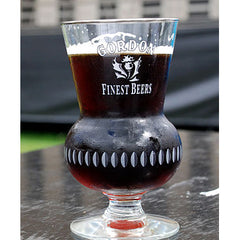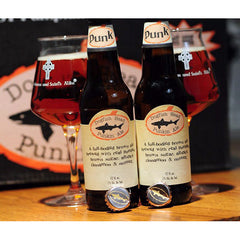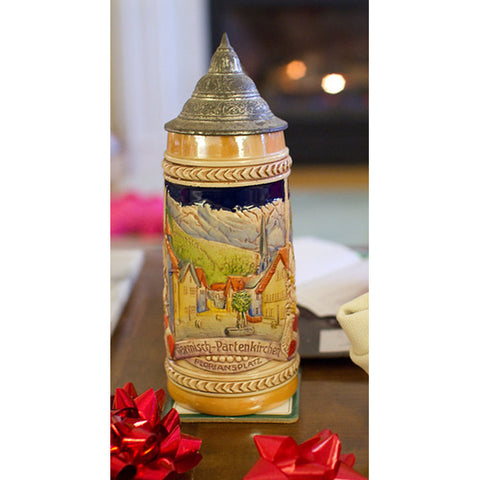Beer Glass Types - Part 2
What are the different types of beer glasses?
By Frank Hamilton
Picking up where we left off, in this second installment, we discuss more types of beer glasses and their uses.
 Jmcstrav
Jmcstrav
The Tulip Glass
This gets its name from its tulip-shaped bowl atop a small stem and footer. The top of the glass curves slightly out, trapping the head and emphasizing the aroma. The thin stem of the glass serves the same purpose as the thick walls of a mug, allowing the user’s hand to rest on the glass without warming the beer inside.
The tulip glass pairs well with stronger, aromatic brews, like:
- Double IPAs
- Belgian ales
- Scottish ales
 Dirk Van Esbroeck
Dirk Van Esbroeck
Thistle
Like the tulip glass, the thistle glass gets its name from its resemblance to the Scottish thistle. The thistle glass is a version of the Tulip glass with an elongated top flowing into a bulbous lower portion that sits atop a short stem. The bulb of the thistle is much smaller than the tulip with a more angular and pronounced top with a slightly flared rim.
As expected the Thistle Glass pairs well with:
- Scottish ales
- Belgian ales
- Any strong, hoppy brew
 jasontho
jasontho
Stout
Stouts are traditionally served in a pint glass or mug. But very recently Colorado’s Left Hand Brewing Company took it upon themselves to partner with the German glassware designer and manufacturer Spiegelau to create a stout glass. The Stout glass looks like an IPA glass without the special ridging along the stem and bottom of the glass. The glass is designed to define the unique stout flavors for the drinker.
These glasses are perfect for, you guessed it:
- Stouts
 Trexer
Trexer
Weizen
Weizen beer glasses, with their slim, tall body and slightly widened mouth are often confused with Pilsner glasses. The unique shape is designed to not only showcase the look, smell, and taste of the beer but also trap the sediments found in wheat beers on the bottom of the glass.
Weizen glasses usually hold half a liter of beer, more than a pint, and should be used to drink:
- All forms of Weizen or Wheat beer
 Thomas Cizauskas
Thomas Cizauskas
Stange
The Stange glass is a visually uninspired tall, slender glass from Germany that’s about as visually unique as a rod or pole. Coincidentally, stange means rod or pole in German. Glass size was traditionally approximately 6.5 ounces, which often prompted quicker consumption before the beer could warm, but modern versions of the Stange are getting larger.
The straight, rod-like, glass concentrates the flavor and preserves carbonation. The glass generally has a thin-walled top flowing into a thick-walled bottom that encourages stability and strength.
This a glass for delicate beers, including:
- Altbier
- Bocks
- Pilsner
- Gose
- Kölsch
- Lambics
- Rye beers
- Rauchbier
 adambarhan
adambarhan
Teku Stemmed
In my opinion, Teku stemmed glasses are one of the most visually appealing choices. The Teku design was created by an Italian craft brewer. The design is wider at the bottom with straight walls tapering toward the top before a slight, but sharp flare at the mouth. These glasses come in two sizes, 11.2 oz or 14.2 oz, and employ the thin stemmed approach to discouraging heat transfer from the user’s hand to the beer.
While some say the Teku style is perfect for all beers, the shape tends to magnify flavor profiles, so exceptionally strong beers can be overwhelming. This glass is recommended for:
- Fruit beers
- Lambics
- Sours
 daveoratox
daveoratox
Stein
Although beer steins are one of the most interesting vessels on the list, they aren’t very common anymore. Beer steins may also have the most variation in appearance. Steins were crafted from a wide variety of material, including pewter, porcelain, silver, stoneware, and wood, and are characterized by a hinged lid on top.
Steins originated in Germany. The word stein is an abbreviation of the original Steinzeugkrug (try asking for another Steinzeugkrug when you’ve had too many beers!) The tankard’s hinged lid was developed to keep flies out of the drink and off the lip of the rim during the bubonic plague.
While most people prefer to drink from a pint, steins are still appropriate for:
- American ales and lagers
- Irish stouts
- Scottish ales
 Didier Descouens
Didier Descouens
Snifter
Most people think of the snifter as an appropriate brandy or cognac glass. Snifters are rarely seen holding a beer. But the same traits that make this a good fit for an aromatic liquor like cognac, also bring out the flavor and aroma profiles of certain beers nicely.
The glass is wide and deep, providing ample room for stirring the volatiles and releasing the beer’s full nose by swirling the beer. These glasses can hold a good portion of beer but are often poured far below the rim to allow for swirling the liquid to release the most aroma. They can also contain a lighter pour because this glass works well with robust, higher alcohol content beers.
Snifters are recommended for:
- Belgian IPAs
- Double IPAs
- Imperial IPAs
So go online, order some interesting glasses, pick up some of your favorite craft beers, grab your trusty GrabOpener, and settle in for a night educating your nose and palate with your new glasses. If you have a beer-loving friend or couple in your life a set of mixed glasses with paired beers and a custom GrabOpener make a great gift. We even have wedding GrabOpeners!
